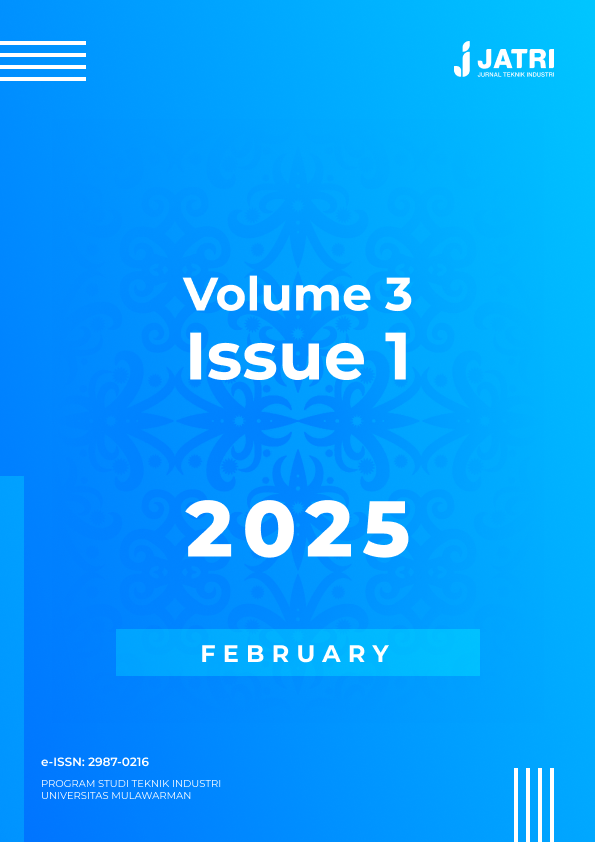Analisis Human Error Dengan Metode SHERPA Dan HEART Pada Budidaya Telur Burung Puyuh
DOI:
https://doi.org/10.30872/jatri.v3i1.1367Abstract
Lovepuyuh UMKM is a business located in Bangun Rejo Village, Tenggarong Oppo District, Tenggarong City, East Kalimantan. This business is engaged in production related to quail such as meat, seeds and quail eggs. Based on LovePuyuh MSME data for each quail egg production process, 80% of the products are classified as perfect products. Meanwhile, 5% of the products were seriously damaged and the other 15% were moderately damaged. This research uses the method Systematic Human Error Reduction and Prediction Approach (SHERPA) and the Human Error Assessment and Reduction Technique (HEART) method. The results of this research show that human error can occur, namely that there are 14 things that can occur in the human error ceramic production process. Human error occurs in 5 main work processes in each sub-job. In the cage preparation process there are 3 human errors, in the breeding process there are 3 human errors, in the cage maintenance process there are 3 human errors, in the health inspection process there are 2 human errors, and in the harvesting process there are 3 human errors. Classification Errors The total work is divided into 9 errors in the action category (action errors), 3 errors in the checking category (checking errors), and 2 errors in the selection category (selection errors). The largest HEP value is found in the quail egg production process, namely in the cage temperature calculation sub-work with a value of 0.99 and the smallest HEP is in the seed type selection process with a value of 0.0000888. Potential errors The biggest problem occurs in the sub-work of cleaning cages from dirt, so special attention is needed from the operator to prevent errors.
References
Alfano, V. A., & Rusindiyanto, R. (2021). Analisis Human error Pada Proses Produksi Gula Dengan Menggunakan Metode Sherpa Dan Heart Untuk Meminimalkan Kecelakaan Kerja Di Pg Rejo Agung Baru Madiun. Juminten, 2(3), 47–58.
Dr. drh. Asmarani Kusumawati, MP. (2017). Kajian Metode Penetasan Terhadap Tingkat Fertilitas Telur Burung Puyuh Desiana Kusuma Wardani
Fathurohman, R., Bakar, A., & Fitria, L. (2014). Analisis kelayakan usaha peternakan burung puyuh di Daerah Pasir Kawung Cileunyi Kabupaten Bandung.
Harva, R. F. (2020). Analisa Risiko Kecelakaan Kerja Pada Produksi Gambir Padat Menggunakan Metode Sherpa dan ECFA di PT. X. Universitas Islam Negeri Sultan Syarif Kasim Riau, Pekanbaru, 1–112.
Kuswana, W.S., 2014, Ergonomi dan K3 (Kesehatan dan Keselamatan Kerja), PT. Remaja Rosdakarya, Bandung.
Panekenan, J. O., Loing, J. C., & Rorimpandey, B. (2013). SONDER KABUPATEN MINAHASA Fakultas Peternakan Universitas Sam Ratulangi Manado , 95115 . PENDAHULUAN Pembangunan subsektor peternakan yang ada di Sulawesi Utara mempunyai peluang untuk dikembangkan mengingat sumberdaya ternak dan sumberdaya pakan cukup te. Jurnal Zootek, 32(5), 1–10.
Patradhiani, R., Kurniawan, M. H., & Rosyidah, M. (n.d.). Analisis Human Error pada Proses Produksi Batu Bata dengan Metode SHERPA dan HEART untuk Mengurangi Kecelakaan Kerja Analysis of Human Error in Brick Production with SHERPA and HEART Method to Reduce Work Accident. 24–31.
Peternakan, F., & Diponegoro, U. (2012). Animal Agricultural Journal, Vol. 1. No. 1, 2012, p 23. 1(1), 23–32.
Retnadila, V., & Indah Pratiwi, S. T. (2019). Analisis Human Error dengan Menggunakan Metode Sherpa dan Heart Pada Proses Produksi Sohun (Studi Kasus: UD. Jaya Grup Daleman). Jurnal Manajemen Industri dan Teknologi (2021)
Saraswati, T. R., Tana, S., & Isdadiyanto, S. (2018). Pakan Organik Metabolisme Pada Puyuh.Mbio.Fsm.Undip.Ac.Id,1–157. Retrieved from https://mbio.fsm.undip.ac.id/v1/wp-content/uploads/2019/01/Buku.pdf
Downloads
Published
Issue
Section
Categories
License
Copyright (c) 2025 Jurnal Teknik Industri (JATRI)

This work is licensed under a Creative Commons Attribution-NonCommercial-ShareAlike 4.0 International License.
















